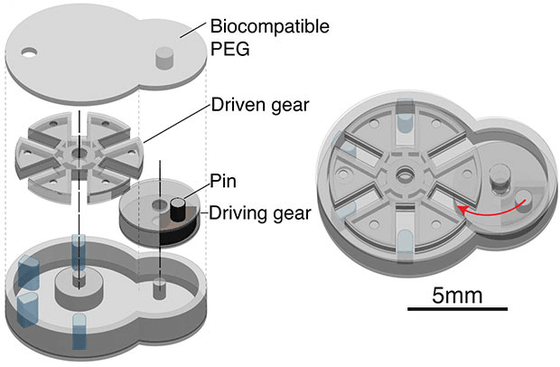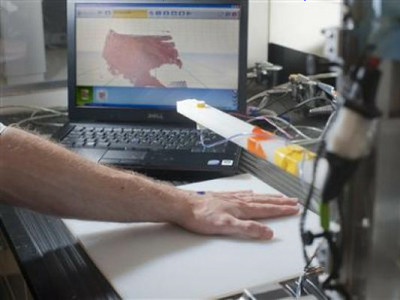Soft bio-bot soft made with a 3D printer that carries cancer remedy directly into the body

Nano robot that can move in the blood and attack the cancer tumor exactlyA biobot has been developed that carries the minimum necessary treatment to the necessary place in the human body and minimizes the side effects of the drug as shown in Fig. This biobot is made with a 3D printer, and it is unique that it has an internal complex mechanism with a size of only 15 mm.
Squishy Clockwork Biobot Could Dose You With Drugs From the Inside - IEEE Spectrum
http://spectrum.ieee.org/the-human-os/biomedical/devices/squishy-clockwork-biobot-could-dose-you-with-drugs-from-the-inside
Swiss watchmaker inventedGeneva mechanismIs built in two gears and is used for watches and projectors. By applying this Geneva mechanism to a biobot of only 15 mm, it is now possible to reliably deliver therapeutic drugs to a targeted location in the body.
This biobot was developed by Professor Samuel Sia who teaches biomedical engineering at Columbia University. Biobot does not use batteries or wires, but can control a small amount of medicine from the outside of the human body. "This biobot is perfect for the modern age that adopts the appropriate treatment for each patient," says Professor Sea of developers.
Professor Sea has already conducted an experiment to treat biobot osteosarcoma using laboratory rats, and the result isScience RoboticsIn a magazineAnnouncementIt is being done.
Professor Sea's team devised a method to make it possible to reproduce the very small Geneva mechanism with a 3D printer first. The idea that the research team devised is to reproduce the Geneva mechanism by laying out hydrogels in layers to create elastic solids. Normally, parts output by 3D printers are assembled using human hands, but it is designed to complete the Geneva mechanism at the moment of skipping this process and outputting it.
A photograph of how to output a Geneva mechanism using a 3D printer

As a result, the time it takes to output the biobot with a 3D printer can be reduced to less than 30 minutes. Note that it takes at least several hours to output the material with a normal 3D printer and assemble a biobot containing the Geneva mechanism. In the first place, most 3D printers can not even handle soft materials like hydrogels.
The state that the output Geneva mechanism is working correctly can be seen in the following movie.
Soft clockwork biobot could dose you with drugs from the inside - YouTube
The one in silhouette like Dharma in the middle is the Geneva mechanism, and the black semicircle in it is iron nanoparticles. Since iron nanoparticles are embedded, you can remotely control the Geneva mechanism by moving the magnet closer. In the following movie, it seems that the mechanism is operated using a silver circle (magnet) under the Geneva mechanism. There are six rooms in the Geneva organization, one of which is a yellow object in medicine.

In addition, Professor Sea's research team is thinking about a way to operate the Geneva mechanism using something other than a magnet. However, the most difficult thing in the development of biobot was that it was compatible with the soft internal organs of the human body, and it was said that we had to manufacture the biobot using a material different from silicon. "If the material you choose collapses, you can not use it to make a robot etc. The material needs to be hard enough to be implanted," she said.
The research team actually put this biobot inside the mouse and verified whether the mechanism works well. The rat who became a subject suffered from osteosarcoma, succeeded in delivering a therapeutic drug locally to this. It seems that the adverse effect on the human body due to the side effect of the therapeutic drug could be made smaller than without using the biobot.

However, Professor Sea says that this biobot is a proof of concept only, there seems to be no idea to put it in practical use in a hurry. "We need to analyze cost-effectiveness and investigate whether this is truly commercially feasible," he says.
Related Posts:







